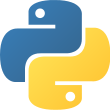A comprehensive guide to exploring modern Python through data structures, design patterns, and effective object-oriented techniques
Key Features
- Build an intuitive understanding of object-oriented design, from introductory to mature programs
- Learn the ins and outs of Python syntax, libraries, and best practices
- Examine a machine-learning case study at the end of each chapter
Book Description
Object-oriented programming (OOP) is a popular design paradigm in which data and behaviors are encapsulated in such a way that they can be manipulated together. Python Object-Oriented Programming, Fourth Edition dives deep into the various aspects of OOP, Python as an OOP language, common and advanced design patterns, and hands-on data manipulation and testing of more complex OOP systems. These concepts are consolidated by open-ended exercises, as well as a real-world case study at the end of every chapter, newly written for this edition. All example code is now compatible with Python 3.9+ syntax and has been updated with type hints for ease of learning.
Steven and Dusty provide a comprehensive, illustrative tour of important OOP concepts, such as inheritance, composition, and polymorphism, and explain how they work together with Python's classes and data structures to facilitate good design. In addition, the book also features an in-depth look at Python's exception handling and how functional programming intersects with OOP. Two very powerful automated testing systems, unittest and pytest, are introduced. The final chapter provides a detailed discussion of Python's concurrent programming ecosystem.
By the end of the book, you will have a thorough understanding of how to think about and apply object-oriented principles using Python syntax and be able to confidently create robust and reliable programs.
What you will learn
- Implement objects in Python by creating classes and defining methods
- Extend class functionality using inheritance
- Use exceptions to handle unusual situations cleanly
- Understand when to use object-oriented features, and more importantly, when not to use them
- Discover several widely used design patterns and how they are implemented in Python
- Uncover the simplicity of unit and integration testing and understand why they are so important
- Learn to statically type check your dynamic code
- Understand concurrency with asyncio and how it speeds up programs
Who this book is for
If you are new to object-oriented programming techniques, or if you have basic Python skills and wish to learn how and when to correctly apply OOP principles in Python, this is the book for you. Moreover, if you are an object-oriented programmer coming from other languages or seeking a leg up in the new world of Python, you will find this book a useful introduction to Python. Minimal previous experience with Python is necessary.
Table of Contents
- Object-Oriented Design
- Objects in Python
- When Objects Are Alike
- Expecting the Unexpected
- When to Use Object-Oriented Programming
- Abstract Base Classes and Operator Overloading
- Python Data Structures
- The Intersection of Object-Oriented and Functional Programming
- Strings, Serialization, and File Paths
- The Iterator Pattern
- Common Design Patterns
- Advanced Design Patterns
- Testing Object-Oriented Programs
- Concurrency
 Language
Language
 Reading time
Reading time
 What you will learn
What you will learn
 Author
Author
 Published
Published
 Packages you will be introduced to
Packages you will be introduced to
